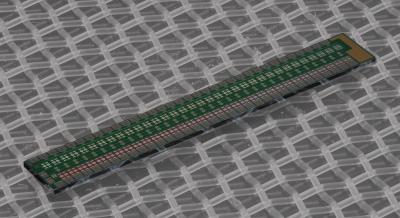NIST chips help BICEP2 telescope find direct evidence of origin of the universe

NIST chip identical to the 16 chips integrated into the BICEP2 telescope camera at the South Pole. Each custom superconducting circuit chip amplifies the electrical signals generated by 32 microwave detectors and assembles them into a sequential time stream. Credit: Schmidt/NIST
A team of U.S. cosmologists using the BICEP2 telescope at the South Pole announced this week that they have discovered the first direct evidence of the rapid inflation of the universe at the dawn of time, thanks in part to technology developed and built by the National Institute of Standards and Technology (NIST).
The BICEP2 camera relies, in part, on the extraordinary signal amplification made possible by NIST's superconducting quantum interference devices (SQUIDs).
The team of cosmologists from Harvard University, the University of Minnesota, the California Institute of Technology/Jet Propulsion Laboratory (JPL) and Stanford University/SLAC used BICEP2 to observe telltale patterns in the cosmic microwave background—the afterglow of the Big Bang almost 14 billion years ago—that support the leading theory about the origins of the universe.
The patterns, so-called “B-mode polarization,” are the signature of gravitational waves, or ripples in space-time. These waves are direct evidence that the currently observable universe expanded rapidly from a subatomic volume in the first tiny fraction of a second after the Big Bang. The project was funded by the National Science Foundation.
Researchers at NIST's campus in Boulder, Colo., made the custom superconducting circuits, or chips, that amplify electrical signals generated by microwave detectors measuring primordial particles of light. JPL made the detectors. The NIST chips, which along with the detectors are chilled to cryogenic temperatures, also assemble the signals into a sequential time stream that can be read by conventional room-temperature electronics.
“This is an exciting and important new result, and we are pleased that technology developed at NIST played a role,” said physicist Gene Hilton, who was responsible for production of the NIST chips.
The 16 NIST chips contain a total of more than 2,000 SQUIDs, which measure the magnetic fields created in coils that carry and amplify the very small currents generated by the detectors. NIST researchers invented a method for wiring hundreds of SQUID signal amplifiers together to make large arrays of superconducting detectors practical—part of the cutting-edge technology that helps make BICEP2 especially powerful.
Physicists just celebrated the 50th anniversary of the SQUID, which has broad applications from medicine to mining and materials analysis—and now more than ever, cosmology.
For more on the BICEP2 discovery, see the Harvard announcement, “First Direct Evidence of Cosmic Inflation,” at http://www.cfa.harvard.edu/news/2014-05.
Media Contact
All latest news from the category: Physics and Astronomy
This area deals with the fundamental laws and building blocks of nature and how they interact, the properties and the behavior of matter, and research into space and time and their structures.
innovations-report provides in-depth reports and articles on subjects such as astrophysics, laser technologies, nuclear, quantum, particle and solid-state physics, nanotechnologies, planetary research and findings (Mars, Venus) and developments related to the Hubble Telescope.
Newest articles

Properties of new materials for microchips
… can now be measured well. Reseachers of Delft University of Technology demonstrated measuring performance properties of ultrathin silicon membranes. Making ever smaller and more powerful chips requires new ultrathin…

Floating solar’s potential
… to support sustainable development by addressing climate, water, and energy goals holistically. A new study published this week in Nature Energy raises the potential for floating solar photovoltaics (FPV)…

Skyrmions move at record speeds
… a step towards the computing of the future. An international research team led by scientists from the CNRS1 has discovered that the magnetic nanobubbles2 known as skyrmions can be…





















